They were there to observe. And I was ready to put on a show.
I was a Store Manager at Starbucks and had received an email notifying me that two people would be visiting my store to observe a morning rush. They were involved in a thing called “LEAN” and the note said they wanted to learn how stores run.
“I can show ‘em how it’s done, alright,” I thought, “but what does the acronym “LEAN” stand for?” Little did I know.
After introducing themselves, they explained that I shouldn’t do anything unusual – but I knew better. People from corporate had visited before. After the last visit, pictures of my food case were circulated as an example of how not to merchandise pastries. Fool me once…
Before I go on to detail the heroics that ensued, a little background may be helpful. Store Managers at Starbucks spend a majority of their time on the floor doing customer-facing activities. Most of the time is spent “running shifts” which includes some administrative tasks but mostly involves deploying Baristas to various workstations and tasks according to customer traffic patterns. For example, two Baristas may be deployed to the register when a lot of customers are in line. At that time, in 2008, Store Managers typically deployed themselves as the “floater.” As the name suggests, this role “floats” in and out of various jobs attempting to relieve bottlenecks and help where needed. The goal is to deliver customers “service with speed.”
Ok, so there I am, The Floater. Like it was yesterday, I can remember the awe inspiring acrobatics: one hand grabbing a pastry while the other groped blindly for a cup. Balancing on one leg while the other kicked open a cabinet door. All the while carrying on a conversation with a customer while nodding at a regular, letting them know that their drink was already in progress. It was spectacular! I may as well have turned my green apron around and worn it as a cape.
The next moment only enhanced my status as a legend in my own mind. I was marking a cup with information yelled to me by a barista minutes earlier while on hold with a vendor from whom I needed to request credit for pastries missing from that day’s delivery; whispering instruction to a trainee that when the parking lot fills up, they should steam as much milk as the pitchers can hold; glancing out of the corner of my eye, noticing that the brewed coffee was getting low and directing another Barista to brew a new batch. All of these things were happening at once, and I had it covered. “Surely these visitors will recommend my immediate promotion,” I remember thinking.
Years later, with better “lean eyesight”, now regularly in the role of observer, I see this scene played out time and time again. Managers and front line workers hustle to work around problems resulting from poorly designed work systems (if it is justifiable to use the words “design” and “system”) and with such pride! We all like to be the hero, I suppose. I certainly did. Knowing what I know now, however, having experienced what I’ve experienced, this scene breaks my heart. Because there really is a better way!
This better way does not require ambidextrous hand-eye coordination. Nor would it allow for flailing legs and arms within a crowded work area. It certainly would not have you treat one customer better than another, at the former’s expense. In this better way, there’s no room for the memory requirements of a super computer to be expected of a human.
With quality built-in, the burden of chasing down credit from a supplier’s stock-out is not applicable. Producing materials in advance of known customer demand? Not in this future state! And what happens to the multi-tasking, superhero who flashes a proud grin every time he vanquishes another fire? Whether he likes it or not, he is transformed into a problem seeker and coach, who systematically facilitates team-based daily improvement. This is done, of course, for the purpose of making the experience better for everyone involved. Customers receive greater value, stakeholders experience more prosperity, and workers develop new capabilities they will carry with them for the rest of their lives.
I’m fortunate to have felt like a superhero in my past life and to have experienced this better way. I know it’s possible. Real examples of superheroes turned problem solver-coaches and fire-fighting cultures turned problem-solving cultures do exist. Yet many will continue with their disbelief. Maybe more fairly, many will just not know how to make it happen and will continue relying on what they do know, the tried and (not so!) true.
But if you do believe (say it with me, there is a better way!), or are interested in giving it a go, start experimenting today. Find a gap between what is actually happening and what should be happening, come up with some ideas that might close that gap, give ‘em a try, and reflect on what happens… then repeat. Plan. Do. Check. Act. It could become your super power.






